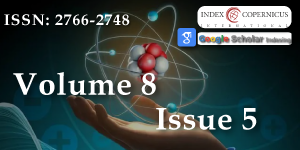Natural Ferromagnetic Resonance in Cast Glass -coated Amorphous Magnetic Micro - and Nanowires and its Applications for Non-contact Diagnostics
Main Article Content
Abstract
The Natural Ferromagnetic Resonance (NFMR) in cast glass-coated amorphous magnetic microwires has been studied theoretically and experimentally. The Natural Ferromagnetic Resonance (NFMR) reveals large residual stresses appearing in the microwire core in the course of casting. These stresses, together with the magnetostriction, determine the magnetoelastic anisotropy. Besides residual stresses, the NFMR frequency is influenced by externally applied stresses on the microwire or the composite containing the so-called stress effect (SE).
The paper analyzes technological aspects of the Taylor-Ulitovsky method used to produce cast glass-coated amorphous magnetic micro- and nanowires.
The dependence of the NFMR frequency on the deformation of the microwires is proposed to be used in the remote diagnostics of critical infrastructure deformations and for remote diagnostics in medicine
Article Details
Copyright (c) 2025 Baranov SA.

This work is licensed under a Creative Commons Attribution 4.0 International License.
1. Taylor F. A method of drawing metallic filaments and a discussion of their properties and uses. Phys Rev. 1924;23:655. Available from: https://doi.org/10.1103/PhysRev.23.655
2. Baranov SA. An engineering review about microwire. Saarbrücken (Germany): Lambert Academic Publishing; 2017. 1-42. Available from: https://ui.adsabs.harvard.edu/abs/2017eram.book.....B/abstract
3. Antonenko AN, Baranov SA, Larin VS, Torcunov AV. Rapidly quenched & metastable materials. Suppl to Mater Sci Eng A. 1997;248.
4. Baranov SA, Larin VS, Torcunov AV. Technology, preparation and properties of the cast glass-coated magnetic microwires. Crystals. 2017;7(6):136. Available from: https://doi.org/10.3390/cryst7060136
5. Baranov SA. J Commun Technol Electron. 2003;48(2):226.
6. Baranov SA. Defects-induced room temperature ferromagnetism in ZnO nanorods grown from ε-Zn(OH)₂. Tech Phys Lett. 1998;24:549. Available from: https://doi.org/10.1021/jp5058226
7. Baranov SA, Yamaguchi M, Garcia KL, Vazquez M. Dimensional absorption high-frequency properties of the cast glass-coated microwires. Surf Eng Appl Electrochem. 2008;44(6):245. Available from: https://link.springer.com/article/10.3103/S106837550806001X
8. Baranov SA. Engineering microwave properties of microwires. Mold J Phys Sci. 2015;14(2):201. Available from: https://ibn.idsi.md/vizualizare_articol/43550
9. Marín P, Cortina D, Hernando A. High-frequency behavior of amorphous microwires and its applications. J Magn Magn Mater. 2005;290–291:1597.
10. Peng H-X, Qin F, Phan M-H. Ferromagnetic microwire composites: from sensors to microwave applications. In: Ferromagnetic microwires composites: from sensors to microwave applications. Switzerland: Springer; 2016. Ch. 12–14. Available from: https://link.springer.com/book/10.1007/978-3-319-29276-2
11. Qin F, Peng H-X. Ferromagnetic microwires enabled multifunctional composite materials. Prog Mater Sci. 2013;58:181–259. Available from: https://doi.org/10.1016/j.pmatsci.2012.06.001
12. Kraus L, Infante G, Frait Z, Vázquez M. Ferromagnetic resonance in microwires and nanowires. Phys Rev B. 2011;83:174438. Available from: https://doi.org/10.1103/PhysRevB.83.174438
13. Kraus L. Theory of ferromagnetic resonances in thin wires. Czech J Phys. 1982;32:1264–1275. Available from: https://link.springer.com/article/10.1007/BF01597425
14. Reynet O, Adenot A-L, Deprot S, Acher O, Latrach M. Effect of the magnetic properties of the inclusions on the high-frequency dielectric response of diluted composites. Phys Rev B. 2002;66:094412. Available from: https://doi.org/10.1103/PhysRevB.66.094412
15. Starostenko SN, Rozanov KN, Osipov AV. Microwave properties of composites with glass-coated amorphous magnetic microwires. J Magn Magn Mater. 2006;298:56–64. Available from: https://doi.org/10.1016/j.jmmm.2005.03.004
16. Yıldız F, Rameev BZ, Tarapov SI, Tagirov LR, Aktaş B. High-frequency magnetoresonance absorption in amorphous magnetic microwires. J Magn Magn Mater. 2002;247:222–227. Available from: https://doi.org/10.1016/S0304-8853(02)00187-7
17. Ménard D, Britel M, Ciureanu P, Yelon A. Giant magnetoimpedance in a cylindrical magnetic conductor. J Appl Phys. 1998;84:2805–2811. Available from: https://doi.org/10.1063/1.368421
18. Ménard D, Yelon A. Theory of longitudinal magnetoimpedance in wires. J Appl Phys. 2000;88:379–384. Available from: https://doi.org/10.1063/1.373671
19. Adar E, Yosher AM, Baranov SA. Natural ferromagnetic resonance in cast microwires and its application to the safety control of infrastructures. J Phys Res Appl. 2020;3:118–122. Available from: https://doi.org/10.29328/journal.ijpra.1001028
20. Makhnovskiy D, Zhukov A, Zhukova V, Gonzalez J. Tunable and self-sensing microwave composite materials incorporating ferromagnetic microwires. Adv Sci Technol. 2008;54:201–206. Available from: http://dx.doi.org/10.4028/www.scientific.net/AST.54.201

